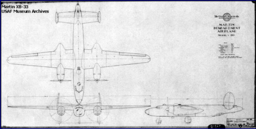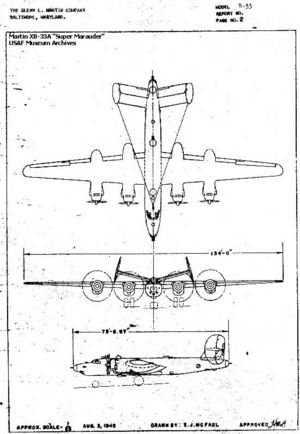PlaneSpottingWorld welcomes all new members! Please gives your ideas at the Terminal.
XB-33 Super Marauder
| B-33 Super Marauder | |
|---|---|
| Type | Medium bomber |
| Manufacturer | Martin |
| Status | Cancelled 1942-11-25 |
| Primary user | U.S. Army Air Force |
| Number built | 0 |
| Developed from | B-26 Marauder |
The Martin B-33 Super Marauder (Martin Model 190) was conceived by Martin as a high-altitude derivative of the Martin B-26 Marauder, that might eventually replace it. The design was different in many ways, most notable in its twin tail (the B-26 had a single tail). It also featured pressurised crew compartments.
Contents
XB-33
The first version of the B-33 design, the XB-33, was a twin-tailed medium bomber with two Wright R-3350 engines and pressurised crew compartments; its design began in 1940. It would carry around 4,000 lb (1,800 kg) of bombs. Soon after design of the XB-33 began, Martin engineers decided it would be more productive to make a drastic overhaul to the design than to continue polishing it. This resulted in the XB-33A. For this reason, no XB-33s were built.
Specifications (as designed):
- Length: 71 ft 0 in (22 m)
- Wingspan: 100 ft 0 in (30 m)
- Height: 22 ft 6 in (6.86 m)
- Engines: 2× Wright R-3350 radial engines of 1,800 hp (1,300 kW) each
XB-33A
As design progressed, it became clear that a two-engine aircraft would not achieve the performance requested by the army. Instead of refining its original design, Martin engineers chose a major alteration of the design, increasing the number of engines to four, and the size of the aircraft was increased to that of the B-29 Superfortress; its bombload was to have been 12,000 lb, as much as that of the B-24 Liberator, the heaviest bomber flown in combat prior to the B-29. This new design, dubbed the XB-33A, was impressive enough that the Army Air Force ordered two prototypes.
Where the original XB-33 was to be powered by the Wright R-3350, the redesigned XB-33A was to use less powerful Wright R-2600 engines. The main reason for this was that the R-3350 was needed for production of the B-29, one of the most highly valued projects of the Army Air Forces.
On 1942 January 17, the Army Air Force placed an order for 402 B-33A Super Marauders. They were to be produced at the government-owned plant in Omaha, Nebraska operated by Martin. However, the entire B-33 project was cancelled on November 25 1942, with the goal of allowing the Martin-operated Omaha plant to concentrate on manufacturing the B-29.
Specifications (B-33A, as designed)
General characteristics
- Crew: 7
- Length: 79 ft 10 in (24.3 m)
- Wingspan: 134 ft (40.8 m)
- Height: 24 ft (7.32 m)
- Wing area: 1,646 ft² (153 m²)
- Empty weight: 85,000 lb (39,000 kg)
- Loaded weight: 95,000 lb (43,000 kg)
- Powerplant: 4× Wright R-2600-15 radial engines, 1,800 hp (1,300 kW each) each
Performance
- Maximum speed: 345 mph (300 knots, 555 km/h)
- Cruise speed: 242 mph (210 knots, 389 km/h)
- Range: 2,000 mi (1,700 nm, 3,000 km)
- Service ceiling: 39,000 ft (12,000 m)
- Rate of climb: ft/min (m/s)
- Wing loading: 58 lb/ft² (280 kg/m²)
- Power/mass: 0.076 hp/lb (55 W/kg)
Armament
- Guns: 8× .50 in (12.7 mm) machine guns
- Bombs: 10,000 lb (4,500 kg)
References and links
- Encyclopedia of American Aircraft
- USAF Museum on XB-33
- USAF Museum on XB-33A
- XB-33 Blueprint
- XB-33A Blueprint
Related content
Related development
Designation sequence
Related lists
Lists relating to aviation | |
|---|---|
| General | Timeline of aviation · Aircraft · Aircraft manufacturers · Aircraft engines · Aircraft engine manufacturers · Airports · Airlines |
| Military | Air forces · Aircraft weapons · Missiles · Unmanned aerial vehicles (UAVs) · Experimental aircraft |
| Notable incidents and accidents | Military aviation · Airliners · General aviation · Famous aviation-related deaths |
| Records | Flight airspeed record · Flight distance record · Flight altitude record · Flight endurance record · Most produced aircraft |


